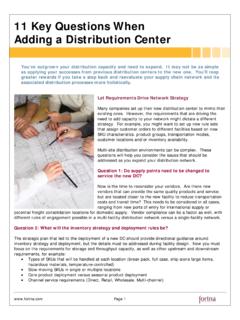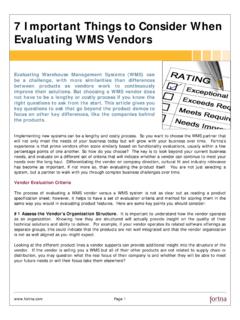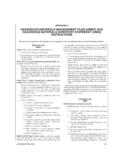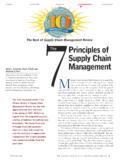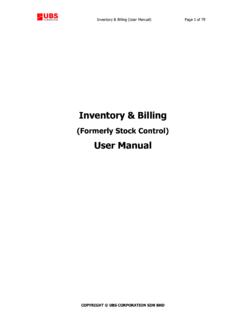Transcription of Case for SKU Management - Home - Fortna
1 Page 1 A case for SKU Management : The Implications of SKU Proliferation You re being pushed to add SKUs or hold on to obsolete or non-moving inventory. But how do you communicate the full implications of holding and handling those additional items to your entire organization? You may get additional sales, but what does that cost you in carrying expenses, capital equipment, customer service, additional cube and strained capacity? This article will help you understand the total impact of SKU proliferation so you can make a case for what to do with all those SKUs. Merchandising wants to add new products in order to attract more customers or increase sales volume. SKU lifecycles are being compressed by changes in product form or functionality resulting from advances in technology. When the company is not willing or able to write-off obsolete or non-performing inventory this results in higher SKU counts.
2 More SKUs add complexity and costs to your distribution operation. Slow-moving or obsolete inventory clogs storage cube and makes less efficient use of material handling storage equipment. Operating space and primary pick faces diminish while labor and operating costs to work around these constraints rise. It s time to consider the full impact of SKU proliferation on your business. What s Behind SKU Growth Organic growth and the introduction of new products are obvious drivers of SKU growth, but there are other good reasons for a rise in SKUs either over time or even quite suddenly: Customers demand higher levels of responsiveness and greater product availability than ever before. This may cause you to carry inventory longer or carry more products in order to honor delivery promises to your customers.
3 Advances in technology mean there are new items entering the market and inventory reaches obsolescence at a faster pace than ever before. Poor product life cycle Management --not having a mechanism to get old or non-performing SKUs out of the supply chain before new ones are introduced is a leading cause of SKU growth. Additionally, mergers/acquisitions can cause both organizations to look at ways to consolidate and reduce inventory and operating costs in order to show value to the market. A case for SKU Management : The Implications of SKU Proliferation Page 2 The Pain is Real There may be good reasons for SKU growth, but the burden of that growth is often underestimated. C ompanies often carry too many SKUs because they don t understand the full impact of: Running out of space Lack of pick face availability Labor and other operating costs to work around constraints Reduced capacity to serve Capital tied up in dead/obsolete inventory Tax issues related to carrying extra inventory Safety incidents related to storage hazards So, how do you make a case for better Management of SKUs?
4 It starts with an integrated approach. SKU Management strategy should be an integrated, cross-organization conversation. Managing your SKU growth effectively requires true business alignment across departments, including stakeholders from Merchandising, Sales, Marketing, Operations, Distribution and Finance. And don t forget to include Supplier Management and Store Operations. The best approach is one that takes a view that includes the broad spectrum of the supply chain manufacturers, retailers, wholesalers and customers. Understanding the Full Impact Once you have the right stakeholders involved, how do you communicate the impact of rising SKU counts? A holistic look at the score card and key indicators will give you a better picture of what SKU growth is really costing you. The chart below shows some typical symptoms associated with SKU proliferation and metrics that paint a picture of the implications to your business.
5 IMPACT AREA SYMPTOMS MEASURED IN INVENTORY Lack of capital Capital tied up in obsolete/slow-moving/aged inventory Carrying inventory as cushion in a long supply chain Inventory Turns Inventory carrying costs as a % of sales Write-offs/mark-downs for obsolete inventory PICKING More labor to get same amount of work done Consolidation activities to try to free up additional slots in forward pick and reserve Lack of pick face availability Pick faces must be turned on a wave by wave basis Increased forward pick media Inefficient travel More frequent handling of product Cost of Goods Sold Cost per Unit Productivity rates Additional labor costs direct and indirect man hours STORAGE High square footage requirements Overcrowding/poor cube utilization Added handling to make room for more inventory Increased offsite storage locations % utilization of reserve storage capacity (85% is optimal)
6 % utilization of forward pick faces Outside storage costs FACILITY & EQUIPMENT Need to lease or buy additional space Additional material handling equipment requirements Sub-optimal forward media Cost of leased space Cost of leased equipment Storage media and related equipment costs CUSTOMER SERVICE Inability to move product through DC in timely manner Inability to deliver the right product on time Out of stocks caused by poor inventory Management Out of stock % Pay outs for missed deadlines Customer complaints Customer attrition PROCESSES Continuous monitoring of slotting to ensure enough pick faces are available Packing out forward pick to free up pick faces for subsequent waves Throughput rates Replenishment costs SAFETY Product stacked in aisles, on docks, in forward pick areas Product placed in storage configurations that create hazardous conditions for associates Safety-related incidents and injuries The Score Card A case for SKU Management : The Implications of SKU Proliferation Page 3 case STUDY A multi-channel retail company was experiencing capacity constraints and struggling to maintain throughput requirements at their sorter.
7 SKU Analysis revealed that, of their 250,000 SKUs, nearly 10% were non-moving SKUs and 10% were touched daily. They found that by aggressively pursuing inventory reduction and better Management of the remaining 200,000 SKUs, they could extend the life of their existing facility for at least three years, increase their throughput capacity during peak season and reduce the amount of capital tied up in inventory. When considering the impact of SKU proliferation, these things must be balanced against the benefits of: Better customer service and ability to provide more options to existing customers Ability to expand in new markets, new geographies and attract new customers More variety and customized products, allowing for broader offerings and wider reach Opportunity to lead in innovation with faster response to market demand What can you do about SKU proliferation?
8 In order to decide on a course of action you need a clear view of what SKU growth is doing within the four walls of your DC and across your network. There are several ways to get a better view of what is happening. SKU Analysis and Cube Utilization Applying the 80/20 rule, 20% of your SKUs represent 80% of your sales volume. In many DCs, a disproportionate amount of on hand inventory is tied to slower moving SKUs. Slow-moving inventory can not only tie up capital that could be used for more important initiatives, but can cost you in other ways, such as buying or leasing space and equipment, higher inventory taxes and increased labor costs/lower productivity as workers take longer to travel (in larger facilities) and re-trace steps. SKU Analysis looks at SKUs by velocity, inventory turns (days on hand), storage media requirements, storage capacity and seasonality.
9 A good analysis will help answer these questions about your inventory: Which SKUs are slow-, fast- or non-moving? What is the financial impact of each of those on your business? How much of your storage capacity is being used by each type of inventory? The results should lead to better decision-making about what to do with each of these types of SKUs. Fortna uses FortnaDCmodeler , a proprietary DC modeling tool, for this type of analysis, which can be performed quickly and provide data that is useful for order profiling, storage media calculations, and what if scenarios based on storage media. A case for SKU Management : The Implications of SKU Proliferation Page 4 SKU Analysis: A Closer Look at The first step in SKU analysis involves looking at velocity.
10 The Good: A & B velocity SKUs represent of the total SKU base yet drive of the unit activity while accounting for of the on hand units The Bad: C & D velocity SKUs represent of the total SKU base yet drive only of the unit activity while accounting for of the on hand units The Ugly: E velocity SKUs drive 0% of the unit activity while accounting for of the on hand units This kind of analysis can help isolate problem areas and lead to better decision making in handling of SKUs. A case for SKU Management : The Implications of SKU Proliferation Page 5 case STUDY A footwear and apparel manufacturer with a rapidly expanding business and continued growth expectations was nearing 100% capacity in the DC. Replenishment costs were high due to daily packing out of forward pick area to free up space for the next day.


